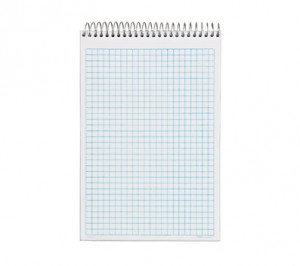Hindsight is in fact about 20/10.
Hindsight is in fact about 20/10.
An ongoing quest.
Even though I’m a computer guy, and type fast, and write illegibly, notebooks are useful. I need to get down little things quick before they distract me from the main line of work, and I need to do little work calculations and drawings that I can’t do as quickly on a computer. And it’s useful to have the pages preserved in order; not very often, but it’s very useful when it does come up.
The TOPS Docket Quad Steno is interesting. It’s the only thing I could find that was top spiral bound and quad ruled (or any kind of graph paper). However, the price that showed just now online is $3 more than I paid in the store, which was already fairly expensive.

Good points:
Bad points:
Other features:
I’ve mostly used side-bound notebooks. Spiral is my definite preference because they open flat. I wanted to try a top-bound, though, and a smaller size again. I was even willing to consider a ruled rather than quad book, but this one turned up and avoided that necessity.

The other decent notebook I know about is the Mead five-star notebook. At least, I think that’s the current version of the one I’m getting towards the end of. Again, issues are decent and heavy paper, and a good firm backing board. Even though I do mostly write on them on a table, I hate them being all floppy. This is about $6, and the pages are bigger, and at least on the older one I have I can often use both sides of the page, so it’s a lot more days of use than the TOPS.
I do like “computation notebooks” (also called “lab notebooks”) in principle; but their bindings don’t lie flat (they’re optimized to make it fairly easy to tell if anything has been removed). They have numbered pages, which makes references easy and also contributes to detecting removals. But I don’t do the kind of work that needs a solid trail for patent applications.
A few companies make composition notebooks in quad rule, but again those don’t open flat, so I don’t find them as attractive to work with.
I’d have a lot more choices if I gave up insisting on quad-rule, but that really helps me organize my pages.
Just reading David Winer’s blog post saying it did.
In installations, that’s clearly not true. In business use, that’s clearly not true. In mindshare…it may well be true. And Apple is supreme in single-company computer sales…but are moving out of that business, it seems to me.
But I don’t want to talk about that.
What I want to talk about is his assertion that malware was a nightmare in the Windows world and in fact drove the Mac win.
That’s just not my experience. I’ve had Windows computers at work the whole time he discusses, and windows computers at home since I first installed Windows 1 (to develop an application). I’ve had full-time (broadband) connected computers at home since 1996. And in all that time, the only virus infection I’ve seen is one Word macro virus that I got in a document sent me by a fellow Minicon committee member. That’s it.
I’ve mostly run an anti-virus program — but it’s never stopped anything (it has, very very occasionally, suggested that something I downloaded from a site I considered dodgy probably contained something bad; but these were all cases where I had deliberately downloaded it, and manually scanned it to make sure because I felt there was cause to worry).
I don’t click things totally at random.
And I mostly don’t go to dodgy sites in the first place. I’m not often looking for illegal software or content, for example.
Malware has had essentially no impact on my user experience. It’s simply not a factor.
I have no idea why my experience is so completely different from Dave Winer’s.
But it’s a bit interesting.